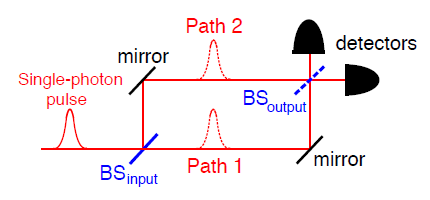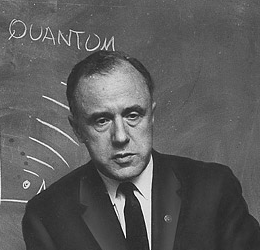
The delayed choice experiment was suggested by John Wheeler in 1978. It is based on and develops further the classic problem for physics that is posed by the double slit experiment. A quick and excellent YouTube video showing the basic paradox is the Dr. Quantum - Double Slit Experiment. The reader should make sure she or he understands that before continuing. (Where by “understands” I actually mean something more like “is suitably dazzled by and acquainted with.”)
The essence of the delayed choice experiment is to run light through a beam splitter that sends half the light left and half right in a random manner, then use mirrors to turn each beam the other way and thus cause them to cross at right angles to each other later. Here is an illustration taken from a scientific paper that actually does this:

In practice, scientists often reduce the light intensity of their beams of light to the point where only a singly photon at a time enters the experimental apparatus, as shown above. This makes the results of the experiment totally clear and possibly even more paradoxical.
Next in the experiment the scientists either put that output BS (beam splitter, that randomly directs the incoming light one way or the other) in or out of the paths of the light as it comes in from the two mirrors. If you watched the Dr. Quantum video, you know that in the standard double slit experiment, the decision to put the output BS in or out of the paths is made before the light is sent into the apparatus. Then in the case of no BS, you get simple, single clumps of photon hits at each detector, but in the case of having it in there, you get diffraction bands of photon hits. The first case is interpreted to mean the light is made up of little photon particles and the second case is taken to mean the light is made up of waves, like water.
When the light comes in a single photon at a time and there is no BS at the end, there will be a single hit at one detector or the other. When several hundred or thousands of photons have done this one photon at a time and we watch how the hits build up over time, we see in the case of no BS at the end the simple, single clumps. This is not a puzzle, as it makes sense to suppose that as each photon was sent left or right by the BS input mirror, at random, by the time we send many photons through, we would get two very similar single clump patters at the detectors.
Puzzling, of course, is the fact, well established now in the science world, that when you do have the output BS in place so that the photons are shifted again left or right, but entirely at random so that we don’t know which path they took (path 1 or path 2), you get the diffraction or wave-interference patterns that mean the light is made up of waves and not particles.
But that’s the standard double slit experiment. We are actually talking about the delayed choice version here. In this version of the same experiment, the scientists have put in place a marvelous switching device that puts the output BS in or out, randomly, in a pico second (1/1,000,000,000,000th of a second). That means they can do it so fast that the random decision to have it there or not is made AFTER the photon of light has entered the apparatus.
This was Wheeler’s idea, not possible to do until not long before he died, but such a great idea. It’s called a delayed choice (as I suppose) because the choice of whether to put the output BS in is made only after the photon has passed through the first BS. However, since the “choice” is made entirely at random by a mechanical device whose choices are determined by a radioactive decay process (or something else “quantum random”), there is no known, sentient chooser in the lab. This already makes the experiment different from the classical one in the sense that there the choices were definitely made by human beings and brought an observer into the picture — the scientist chose to know, by his choice to use or not use the output BS, which path the photon took or not to know.
by way of a metaphor that imagines the photon choosing whether or not it’s going to act like a wave or act like a particle.

I found this photo of John A. Wheeler in his obituary in the New York Times of April 14, 2008:
John A. Wheeler, a visionary physicist and teacher who helped invent the theory of nuclear fission, gave black holes their name and argued about the nature of reality with Albert Einstein and Niels Bohr, died Sunday morning at his home in Hightstown, N.J. He was 96.
Since discovering this version of the Delayed Choice Quantum Eraser, I have found another one that is possibly even clearer and more strange in its results. See here or here or, perhaps best, most recent, here.

| The Fifth Remembrance 1 |
| The Fifth Remembrance 2 |
| The Fifth Remembrance 3 |
| Dr. Block and Isys 1 |
| Dr. Block and Isys 2 |
| Dr. Taylor and near death 1 |
| Doris's Death |
| Whose journey? Whose truth? |


